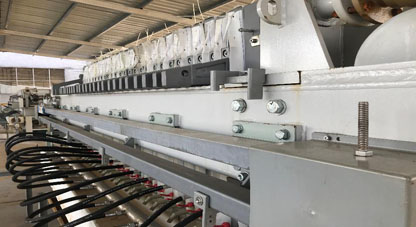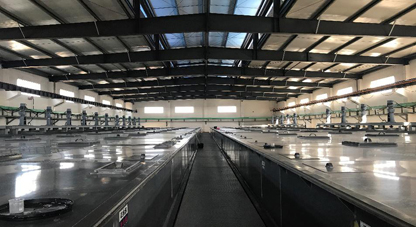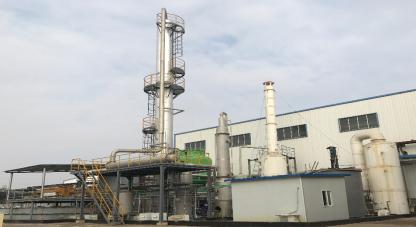
(1) Lithium battery recycling concept
"Using limited resources to create unlimited value" business philosophy, relying on the company's "National Enterprise Technology Center", "Lithium-based New Materials National and Local Joint Engineering Research Center" and other advantageous R&D innovation platforms, focusing on scientific research and development, and advocating "green chemical industry", Safely and harmlessly dispose of used batteries to realize the recycling of resources; and in an efficient, clean, and sustainable way to help customers reduce environmental protection costs, increase customer benefits, and enhance corporate competitiveness.
(2) Photos of lithium battery recycling production line

Dismantling line for used batteries

Waste lithium iron phosphate battery processing line (partial)

Waste ternary battery processing line (partial)

Precursor workshop processing line (partial)
(3) Lithium battery recycling technology and process characteristics and advantages
At this stage, lithium battery recycling technology is mainly divided into waste lithium iron phosphate battery recycling technology and waste ternary battery recycling technology. The waste lithium iron phosphate battery recycling technology uses waste lithium iron phosphate batteries as raw materials to prepare lithium chloride solution through discharge, dismantling, crushing, acid leaching, and impurity removal, and then enter the company's lithium chloride production system to prepare anhydrous lithium chloride , Battery grade lithium carbonate, lithium hydroxide and other products; waste ternary battery recycling technology uses waste ternary lithium batteries as raw materials, through discharge, primary crushing, powder selection, acid leaching, impurity removal, lithium precipitation and other processes to obtain nickel, cobalt and manganese Purification solution: The nickel, cobalt and manganese purification solution is prepared through co-precipitation, filter press separation, drying and other process steps to prepare ternary precursors. The production process efficiently separates the extractant and by-products, reduces material consumption, improves resource recovery, and reduces The cost of the three waste treatment.
The main products of the lithium battery recycling project are battery-grade lithium carbonate, lithium hydroxide, and ternary precursor materials. These three main products are all key new products in Jiangxi Province, and their technological level has reached the domestic leading level after being appraised by relevant experts organized by the Provincial Science and Technology Department. The core technology of the project has been authorized with 2 national invention patents: (1) A method for removing cobalt and manganese by preparing nickel sulfate solution using nickel, cobalt and manganese hydroxide as raw materials (ZL 201310552644.7); (2) A ternary cathode material precursor Preparation method (ZL 201310485720.7).
The production equipment selected for the lithium battery recycling project has a high degree of automation, and the materials, rigidity, strength, operation control system, and safety protection devices must meet the specifications. The equipment is advanced in technology, reliable in production performance and durable. According to the operating conditions, process media characteristics and product requirements, various equipment shall be standardized products in principle, and non-standard equipment shall be separately designed according to relevant national standards. The advanced nature of the project is explained as follows: (1) The project uses domestic advanced equipment, the production process and equipment selection have fully considered the coordination between the various operating steps, and the reasonable combination of reaction materials is carried out to reduce the production links. (2) Each main equipment is equipped with frequency conversion equipment, which can save 10-15% of electric energy, and can reduce mechanical equipment failures, and save energy consumption while ensuring continuous production; (3) 1) Anti-corrosion materials are selected for the main reaction vessel of this project to reduce the corrosion of reaction materials to the equipment and ensure the safe progress of the reaction; (4) Realize automatic operation. On the one hand, due to the automatic control, the stability of the device is improved, and the overall average yield is improved; on the other hand, the extensive use of automatic interlock protection, online analysis, and safety control instrumentation greatly improves the safety of the device.
(4) Development trend of lithium battery recycling market
In 2017, the total global sales of new energy vehicles exceeded 1.42 million, and the cumulative sales exceeded 3.4 million. As of the end of 2017, the cumulative sales of new energy vehicles in my country reached 1.8 million, more than 50% of the cumulative global sales. Among them, the sales of new energy vehicles in 2017 was 777,000, a year-on-year increase of 53.3%. Among them, 652 thousand pure electric vehicles were sold, an increase of 59.6% year-on-year. The power battery life is generally 5 to 8 years. With the continuous increase in the production and ownership of new energy vehicles in my country, power batteries will reach a small peak of scrap around 2020. According to statistics, from 2002 to 2006, the number of scrapped lithium-ion batteries in China was about 200-500 tons per year. It is estimated that by 2020, the number of scrapped lithium-ion batteries worldwide will be 32.2 GWh, about 500,000 tons, of which China’s cumulative lithium-ion batteries The amount of scrap is 120,000 to 200,000 tons. How to dispose of these scrap batteries has become a problem that cannot be underestimated. On the one hand, used lithium-ion batteries contain a variety of harmful substances, such as organic solvents, heavy metals and toxic gases. On the other hand, the cathode materials of used lithium-ion batteries usually contain valuable metal elements such as lithium, cobalt, nickel, manganese, iron and aluminum. The large-scale power lithium battery market will be accompanied by industry opportunities for lithium battery recycling and downstream echelon utilization. The development of lithium battery recycling and echelon utilization will avoid resource waste and environmental pollution while also generating considerable economic benefits and investment opportunities.
According to calculations, the market scale created by recovering cobalt, nickel, manganese, lithium, iron and aluminum and other metals from waste power lithium batteries will begin to explode in 2018, reaching 5.2 billion yuan in 2018 and 13.6 billion yuan in 2020. It will exceed 30 billion in 2023. Therefore, it is of great significance to carry out research on waste lithium battery recycling technology. On the one hand, it can solve the environmental pollution caused by waste lithium batteries; on the other hand, it can recover valuable metal elements such as lithium, nickel, cobalt, and manganese to realize comprehensive recycling of resources and alleviate Lithium resources are tight.